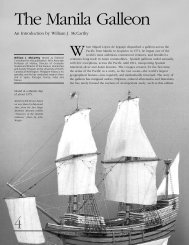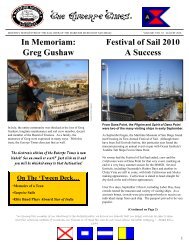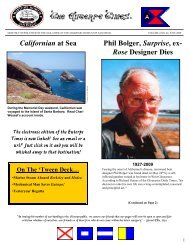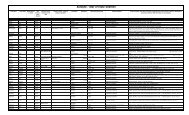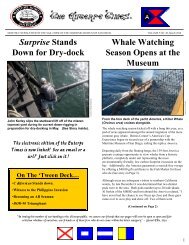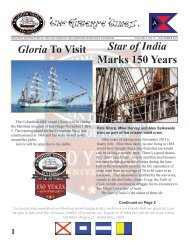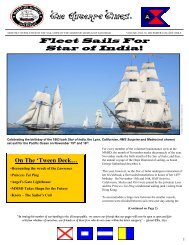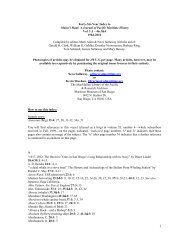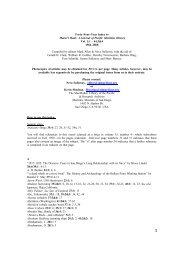Early American Trade with China - Maritime Museum of San Diego
Early American Trade with China - Maritime Museum of San Diego
Early American Trade with China - Maritime Museum of San Diego
You also want an ePaper? Increase the reach of your titles
YUMPU automatically turns print PDFs into web optimized ePapers that Google loves.
The <strong>American</strong>s developed the previously modest fur trade, and soon<br />
dominated it. An enormous growth in the fur trade is apparent in<br />
British Company records, even though many <strong>American</strong> captains<br />
preferred to smuggle their furs through the back doors <strong>of</strong> the Celestial<br />
Kingdom. In 1792 the English sold 77,330 “fine furs” such as sea and river<br />
otter, beaver, fox, marten, and fur seal, while the <strong>American</strong>s sold only 7,579,<br />
or one tenth as many. These roles soon reversed. From 1800 to 1804, the<br />
English annually sold an average <strong>of</strong> 26,776 fine furs, while the <strong>American</strong>s’<br />
annual average was no less than 324,264 sold. Of the latter total, ninety<br />
percent were fur seal skins, worth altogether about a quarter <strong>of</strong> a million<br />
dollars each year. Sea otter pelts, though far fewer in number, were much<br />
more valuable, and the 42,527 sold by <strong>American</strong>s <strong>of</strong>ficially in Canton in 1802<br />
probably fetched close to a million dollars. Moreover, almost all <strong>of</strong> that was<br />
pr<strong>of</strong>it, since the expenses incurred in sealing or in trading on the Northwest<br />
Coast were very small indeed.<br />
<strong>American</strong> purchases were much less varied, <strong>with</strong> black teas generally well<br />
over half the total in value. In 1792, for example, teas accounted for half the<br />
total <strong>American</strong> cargoes by value, wrought silks for twenty percent, and<br />
quicksilver (mercury) for fifteen percent. Comparatively small shipments <strong>of</strong><br />
raw silk, sugar, durable “nankeen” cloth, porcelain, lacquered goods and<br />
other “<strong>China</strong> wares” made up the remainder. But here again the small size <strong>of</strong><br />
the <strong>American</strong> vessels is evident, for although over these two decades<br />
<strong>American</strong> vessels numbered twenty percent <strong>of</strong> the total, they carried on<br />
average only ten percent <strong>of</strong> the tea exported, and under four percent <strong>of</strong> the<br />
silk.<br />
Initially, the long-established European merchants were amazed that the<br />
<strong>American</strong> cockleshell adventurers could survive and prosper in such<br />
competitive, speculative trades. Ultimately, however, it was the restrictive<br />
chartered monopolies like the British and Dutch East India Companies that<br />
could not survive against the freer competition <strong>of</strong> the small, individuallyowned<br />
vessels <strong>of</strong> the <strong>American</strong>s.<br />
Sea otter fur was worn by high<br />
mandarins in coat linings or collars,<br />
esteemed for its lushness—otters have<br />
about 650,000 hairs per square inch,<br />
while the entire scalp <strong>of</strong> an average<br />
human has only 100,000. Yankees,<br />
Britons, Russians, Aleuts, and even<br />
California Indians hunted them. Pelts<br />
fetched $30 apiece on Canton’s streets<br />
in 1830, where the fur seller below was<br />
painted around 1805. Only opium,<br />
smoked by addicts in “dens” like the<br />
one engraved in 1843 at left, proved<br />
more lucrative.<br />
Above, John James Audobon, below, © 2003<br />
The Kelton Foundation<br />
“ F o r A l l t h e T e a i n C h i n a ” : A m e r i c a , A u s t r a l i a , a n d T h e C h i n a T r a d e<br />
17



